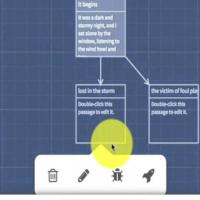Twine
Item
- Title
- Description
- Form filler
- Creator and affiliation
- Current owner
- Current ownership type
- Year of first release
- End-product media type(s)
- Main target audience(s)
- Available modes of creation
- Role of coding in creative process
- Life status
- Product portal
- Homepage URL
- Reference citations/URL(s)
- Use license cost
- Publishing license model
- Programming language written in
- Author-facing programming/scripting language(s)
- Authoring tool work platform(s)
- End-product work platform(s)
- Available supporting technical resource(s)
- Self-containment
- Primary design focus
- Primary authoring action(s)
- Main interface window(s)
- Designable general element(s)
- Designable narrative specific element(s)
- Built-in preset element(s)
- Overall difficulty assessment
- Work environment/design interface intuitiveness
- Learning curve complexity
- Advanced authoring complexity
- Depth of advanced authoring
- Degree of narrative specific emphasis
- Role of procedural authoring
- Types of available procedural authoring
- End-product control interface
-
Twine
-
Twine (and Twine 2) is the most widely-used tool for interactive fiction authoring. It is an open- source HTML-based tool that’s user-friendly intuitive and easy to learn. Twine highlights the visual structure of a hypertext story: the interface is based around creating and editing hypertext units (“passages”) and controlling their organization in an abstracted space. New hypertext units are created by typing in existing ones either through links or conditional logic.
-
Yotam Shibolet
-
Chris Kilmas
-
Open source run by Kilmas alongside a community of volunteers
-
Community-run/Fully open-source
-
2009
-
Interactive text
-
Students
-
Amateurs/enthusiasts
-
Professional interactive narrative authors
-
Creative people (no programming skills)-targeted tool
-
Nodes and links creation mode (e.g. Twine)
-
Optional
-
Alive (actively moderated and updated and/or active community of authors)
-
https://ifdb.org/search?searchfor=system%3Atwine&searchgo=Search+Games
-
https://twinery.org/
-
Kolb David. "Narrative hypertext on the level." In Proceedings of the 3rd Narrative and Hypertext Workshop p. 3. ACM 2013.
Hahn Richard. "Collaborative Creative Writing in the L2 Classroom Using the Software Twine." In Conference Proceedings. The Future of Education p. 137. libreriauniversitaria. it Edizioni 2016.
Friedhoff Jane. "Untangling Twine: A Platform Study." DiGRA Conference. 2013.
Ruggiero Dana and Laura Green. "Make good choices: exploring narrative game design with young people in prison." Proceedings of the The 15th International Conference on Interaction Design and Children. ACM 2016.
Salter Anastasia. "Learning Through Making: Notes on Teaching Interactive narrative." Syllabus 4 no. 1 2015.
Starks Katryna Dakoda Barker and Alayna Cole. "Using Twine as a Therapeutic Writing Tool for Creating Serious Games." Joint International Conference on Serious Games. Springer Cham 2016.
-
Free license
-
Unrestricted publishing
-
Written in Javascript
-
HTML authoring
-
Windows
-
Mac
-
Linux
-
PC/Macintosh support
-
Android support
-
Browser support
-
iOS support
-
https://github.com/klembot/twinejs
https://github.com/tweecode/twine
https://github.com/pypa/twine
-
Fully Self-contained
-
Nodes & links (linking between individual segments e.g. Twine)
-
Manipulating extendable objects\blocks (e.g. Twine)
-
Individual lexia editor
-
Nodes & links graph
-
Nodes and links structure (any medium)
-
Interactive text paragraphs
-
Audio/sound
-
Props/items
-
Abilities
-
Rules/Constraints
-
Environmental/Character States
-
State-triggered story events
-
Layout presets of the final product
-
Easy authoring difficulty
-
Highly intuitive
-
Easy to learn
-
Medium complexity
-
Large depth
-
Central narrative-specific emphasis
-
Nonexistent procedural authoring
-
Randomized integers
-
Mouse & keyboard
- Item sets
